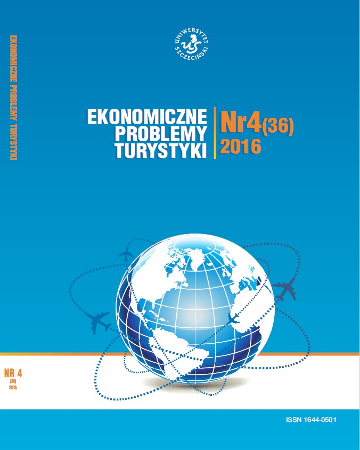
ISSN: 1644-0501
eISSN: 2353-3188
OAI
DOI: 10.18276/ept.2017.4.40-04



Issue archive /
nr 4 (40) 2017
Concepts of Event Loyalty and Destination Loyalty Based on the Example of Sports Fans of Poznan Half Marathon
| Authors: |
Joanna
Poczta
University of Physical Education in Poznan, Department of Tourism and Recreation Ewa Malchrowicz-Mosko University of Physical Education in Poznan, Department of Tourism and Recreation Nuno Almeida Polytechnic of Leiria and University of Coimbra |
| Keywords: | destination loyalty event loyalty half marathon |
| Data publikacji całości: | 2017-12-30 |
| Page range: | 10 (39-48) |
| Klasyfikacja JEL: | I31 |
Abstract
This article explores the research problem of building loyalty of tourists towards sports events and tourist destinations, whose roots are in behavioral marketing. The work includes an overview of literature focused on tourist loyalty towards a sports event, and further on – towards a tourist destination. It presents the concepts which made it possible to create assumptions for conducting empirical research during the 6th Poznan Half Marathon. The aim of the study was to determine the factors influencing the spectators’ loyalty towards this event and subsequently towards the destination. The study focused on the attempt to determine whether loyalty can be built also among sports fans, because foreign language publications are typically concerned with athletes. It appears that the conducted research confirms the assumptions adopted on the basis of the literature and proves that the loyalty of a sports fan towards the event is influenced by: motivations for passive participation in the event (push and pull), socio-demographic factors, and a sense of satisfaction from supporting the athletes, who are often close to them.
Download file
Article file
Bibliography
| 1. | Baker, D.A., Crompton, J.L. (2000). Quality, satisfaction and behavioral intentions. Annals of Tourism Research, 3 (27), 785–804. |
| 2. | Beerli, A., Martín, J.D. (2004). Tourists’ characteristics and the perceived image of tourist destinations: a quantitative analysis – a case study of Lanzarote, Spain. Tourism Management, 5 (25), 623–636. |
| 3. | Bigné, J.E., Andreu, L. (2004). Emotions in segmentation: an empirical study. Annals of Tourism Research, 3 (31), 682–696. |
| 4. | Bitner, M.J. (1990). Evaluating service encounter: the effects of physical surroundings and employee responses. Journal of Marketing, 54, 69–82. |
| 5. | Bowen, D. (2001). Antecedents of consumer satisfaction and dis-satisfaction (CS/D) on Long-Haul inclusive tours: a reality check on theoretical considerations. Tourism Management, 22, 49–61. |
| 6. | Court, B., Lupton, R. (1997). Customer portfolio development: modelling destination adopters, inactives, and rejecters. Journal of Travel Research, 1 (36), 35–43. |
| 7. | Crompton, J.L. (1979). Motivations for pleasure vacation. Annals of Tourism Research, 4 (6), 408–424. |
| 8. | Flavian, C., Martinez, E., Polo, Y. (2001). Loyalty to grocery stores in the Spanish market of the 1990s. Journal of Retailing and Consumer Services, 8, 85–93. |
| 9. | Hallowell, R. (1996). The Relationship of Customer Satisfaction, Customer Loyalty, Profitability: An Empirical Study. International Journal of Service Industry Management, 4 (7), 27–42. |
| 10. | Halpenny, E., Kulczycki, C., Moghimehfar, F. (2016). Factors effecting destination and event loyalty: examining the sustainability of a recurrent small scale running event at Banff National Park. Journal of Sport & Tourism, 3–4 (20), 233–262. |
| 11. | Kozak, M., Rimmington, M. (2000). Tourism satisfaction with Mallorca, Spain as an off-season holiday destination. Journal of Travel Research, 3 (38), 260–269. |
| 12. | La Barbara, P.A., Mazursky, D. (1983). A Longitudinal Assessment of Consumer Satisfaction/Dissatisfaction: The Dynamic Aspect of the Cognitive Process. Journal of Marketing Research, 20, 393–404. |
| 13. | Mazursky, D. (1989). Past experience and future tourism decisions. Annals of Tourism Research, 16, 333–344. |
| 14. | Oh, H. (1999). Service quality, customer satisfaction, and customer value: a holistic perspective. International Journal of Hospitality Management, 18, 67–82. |
| 15. | Santos, V., Ramos, P., Almeida, N. (2014). Consumer behaviour in tourism: A content of analysis of relationship between involvement and emotions. Journal of Tourism Research, July. |
| 16. | Sato, M., Jordan J.S., Funk D.C. (2016). A distance-running event and life satisfaction: The mediating roles of involvement. Sport Management Review. |
| 17. | Turnbull, P., Wilson, D.T. (1989). Developing and protecting profitable customer relationships. Industrial Marketing Management, 18, 233–238. |
| 18. | Um, S., Chon, K., Ro, Y. (2006). Antecedents of revisit intention. Annals of Tourism Research, 4 (33), 1141–1158. |
| 19. | Yoon, Y., Uysal, M. (2005). An examination of the effects of motivation and satisfaction on destination loyalty: a structural model. Tourism Management, 1 (26), 45–56. |
| 20. | Yürük, P., Akyol, A. (2017). Analysing the effects of social impacts of events on satisfaction and loyalty. Tourism Management, 60, 367–378. |